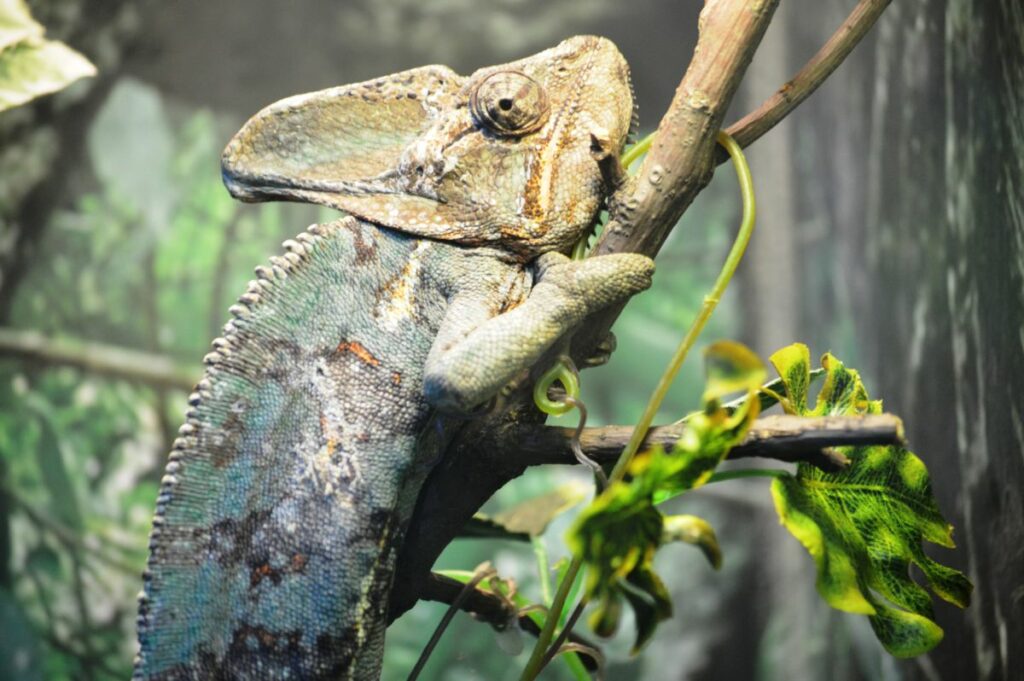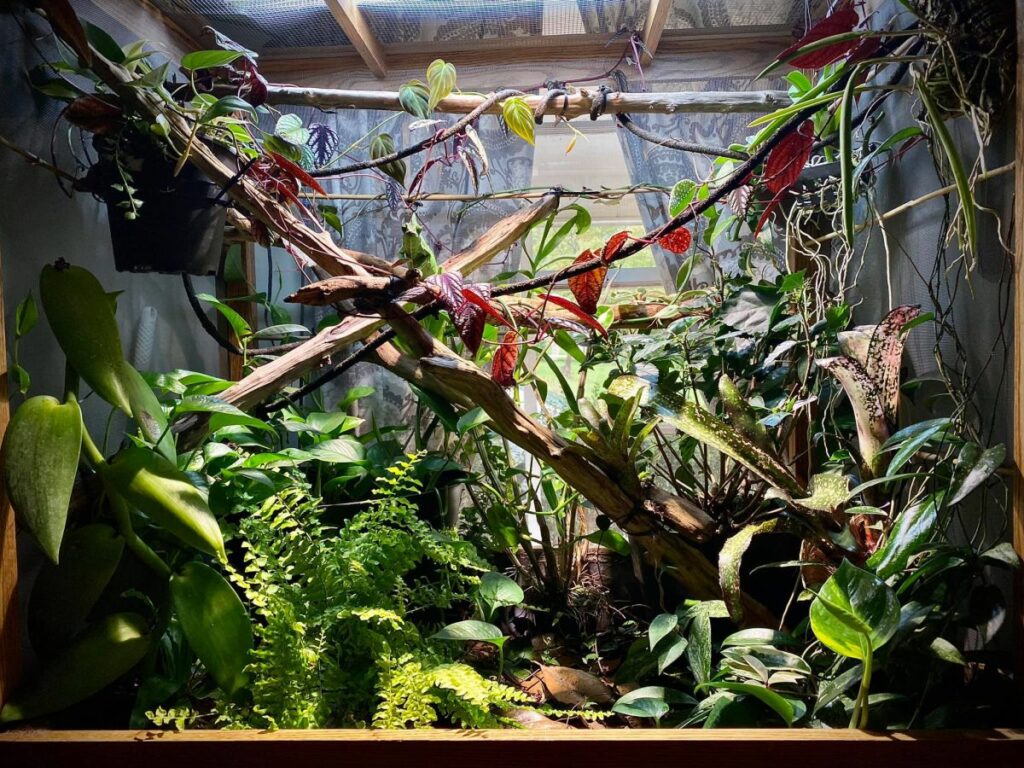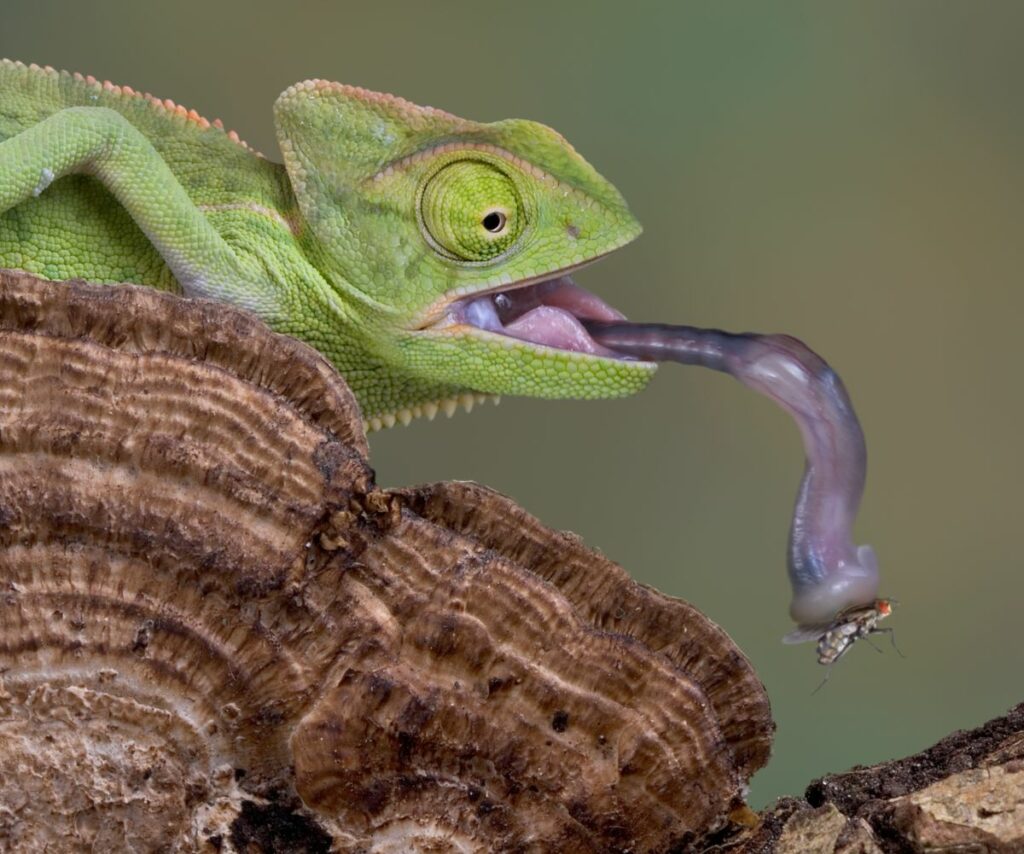Caring for a veiled chameleon requires more of your time compared to a leopard gecko or other beginner reptile. Chameleons are amazing to watch as they shift color and hunt down their prey in slow motion. You need to pay close attention to their diet, temperature, and lighting needs, however.

What is the Veiled Chameleon?
Veiled chameleons are found in Saudi Arabia and Yemen. World-famous for their ability to dramatically change colors, chameleons have a number of unique adaptations.
Veiled chameleons do change colors to blend into their environment at times. But their hue shifts are more important for social signaling and displaying their mood. When a chameleon is excited, relaxed, angry, etc, they change colors.
Their grasping feet and prehensile tails allow them to securely move through the treetops. Chameleons even have eyes that move independently of one another, giving the brain a full 360° view around them.
They also have excellent visual acuity; some of the best of any vertebrate animal. Their sharp vision is perfect for where they live. In the treetops, up and down are often subjective.
Veiled chameleons use their long, sticky tongue to snatch insects from long distances. The organ loads potential energy into elastic tissues that stay ready. Once released, the tongue extends up to twice the length of the chameleon’s body.
Sticky, mucus-laded saliva ensures that even a glancing blow with an insect results in it being stuck. The chameleon then reels its tongue in to crunch its meal using powerful jaws and teeth.
Here is a video that demonstrates the speed and accuracy of a chameleon’s tongue using slow-motion footage:
Veiled Chameleon Lifespan in Captivity
Veiled chameleons are not as long lived as other lizards their size. Eight years is an average lifespan for a male veiled chameleon. Females are smaller and not as long lived. Five years is typical for an adult female.
- Common Names: Veiled Chameleon, Yemen Chameleon
- Scientific Name: Chamaeleo calyptratus
- Origin: Arabian Peninsula
- Length: 10 to 14 inches (females) or 18 to 24 inches (males)
- Enclosure Size: 3 x 4 x 3 feet
- Diet: Omnivorous
- Veiled Chameleon Lifespan: 4 to 6 years
- Ease of Care: Difficult
Veiled Chameleon Care
Chameleons are one of the more difficult pet lizards to care for. They need a diverse diet, ideal humidity, and the right light output. These requirements all change depending on the species as well. Choose a veiled chameleon once you’ve mastered the basics of reptile keeping.
Veiled Chameleon Habitat Setup

Once you see a chameleon holding things you will understand why a proper chameleon enclosure is full of branches. These lizards live in a 3-D world and need vines, twigs, and other tree substitutes to feel comfortable.
While you don’t need a large tank, avoid going with a glass tank. Glass does not offer enough airflow for a veiled chameleon. Mesh enclosures are the way to go.
Higher air flow complicates keeping chameleons that need higher humidity levels. But veiled chameleons require 50-70% humidity.
Adding live plants to the enclosure helps maintain the humidity at the right level. As does choosing a substrate that holds moisture, such as coco coir or peat.
I also recommend using misters for chameleons. Automatic misters measure the humidity and add a blast of vaporized water as needed.
A bowl of water in the enclosure also helps moderate the humidity levels. Veiled chameleons almost never drink from standing water, however. They prefer to drink moisture that accumulates from mist on their skin and from plant leaves.
Lighting for Veiled Chameleons
Veiled chameleons need visible, infrared (heat), and ultraviolet (UVb) light for their health. Basking bulbs give off heat to allow a chameleon to thermoregulate.
As ectothermic animals chameleons don’t produce body heat like us mammals do. They need heat from their environment to digest their food, grow, and fight diseases.
Veiled chameleon temperature under the basking bulb should be 90-95℉. With an ambient air temperature of 80℉ for the rest of the enclosure .
UVb rays come from specialized bulbs that are added in addition to the basking bulbs. These bulbs are replaced every 6 months, even if they continue to emit visible light. Remember, ultraviolet rays are invisible to us. So you can’t rely on the light going out as a clue.
Ultraviolet rays are critical for reptile health. They allow lizards to synthesize vitamin D3 from the rays of the sun. Vitamin D3 facilitates calcium uptake from their diet. Without it, reptiles suffer from metabolic bone disease.
MBD is a disorder that is fatal if left untreated. And even if caught, a lizard may have irreversible damage in the form of a twisted spine or limb bones.
What Does a Veiled Chameleon Eat?

Most chameleons are insectivorous. Their sticky tongues and incredible vision all help them snatch insects from afar. But a few species, including the veiled chameleon, are omnivorous.
These lizards eat small amounts of fruit and vegetables as well. Veiled chameleons eat these in the wild during the wet season, possibly for their water content.
In captivity, you still want to focus on the animal protein portion of their diet. A blend of 80% insects and 20% vegetables is recommended. Even then, monitor your lizard with care and adjust the amount and frequency of vegetables you offer. If the lizard starts eating too many vegetables, stick to insects for a few feedings.
Shredded squash, zucchini, cucumber, lettuce, kale, and dandelion greens are all good options. Soft fruit like berries can be added on top of their salad, with a dusting of vitamin powder for extra calcium.
You also need to vitamin dust and gut-load any insects you feed to your veiled chameleons. Gut loading is pre-feeding insects with vegetables and fruit. When a predator that eats these insects they take on the nutrition from the predigested food
Veiled chameleons will eat crickets, mealworms, dubia roaches, and other common pet store feeder insects. You can offer wax worms as an occasional treat since these are high in fat.
Baby veiled chameleon care involves feeding your pet lizard every day. As they grow larger, you should switch to feeding every other day.
Do Chameleons Like to be Held?
You could tame a chameleon so that it stops hissing or trying to bite you. But they never enjoy being handled. Chameleons of all species are solitary, territorial animals. They don’t even enjoy their own kind very much.
Veiled chameleons are no exception and should be handled only when necessary. That said, it is still a good idea to get them used to being handled. Doing tank maintenance and catching the lizard for a vet visit are much easier with a tame chameleon.
One strategy for taming a veiled chameleon is hand feeding. Use treats like wax worms when hand feeding. The chameleon will start to associate your hands and presence with positive experiences.
Second, you should give the chameleon a choice to engage with you or not. Once it stops being fearful of your presence, try placing a finger or arm in front of it. The chameleon may treat it like a branch and climb on. If it refuses, try again the next day.
Avoid reaching in and picking up a veiled chameleon unless you have to. The lizards hate being held in this way. Chameleons are also fragile animals, with thin bones. They are slow moving and don’t thrash too hard.
But a fall will cause a chameleon severe injury. It’s best to think of a veiled chameleon as a hands-off pet to watch.
Conclusion
Veil chameleons are one of the more difficult lizards to keep. Yet they are also one of the most unique pets around.
If you are going to have a lizard that should not be held, it might as well be interesting to watch. Chameleons, with their color changes, alien eyes, long tongues, and grasping feet, are well worth the trouble.
More FAQs About Veiled Chameleon Care
An adult male veiled chameleon is one of the larger pet lizards in the hobby. They mature between 18 and 24 inches in length. Female veiled chameleons are much smaller. 10 to 14 inches is typical for one. Female chameleons also don’t live as long as males do.
Chameleons are able to shift their colors with ease. But their body shape does not change. Veiled chameleons have a bony crest on their heads called a casque. The exact purpose of the casque is not certain. But it seems to be a multi-purpose organ that demonstrates the virility of the animal. As well as channeling condensed moisture down to its mouth.
The largest species of chameleon is a dual-record. The Parson’s Chameleon (Calumma parsonii) and Malagasy Giant Chameleon (Furcifer oustaleti) are tied in size. Adult males of both species grow up to 27 inches long and are similar in weight.
